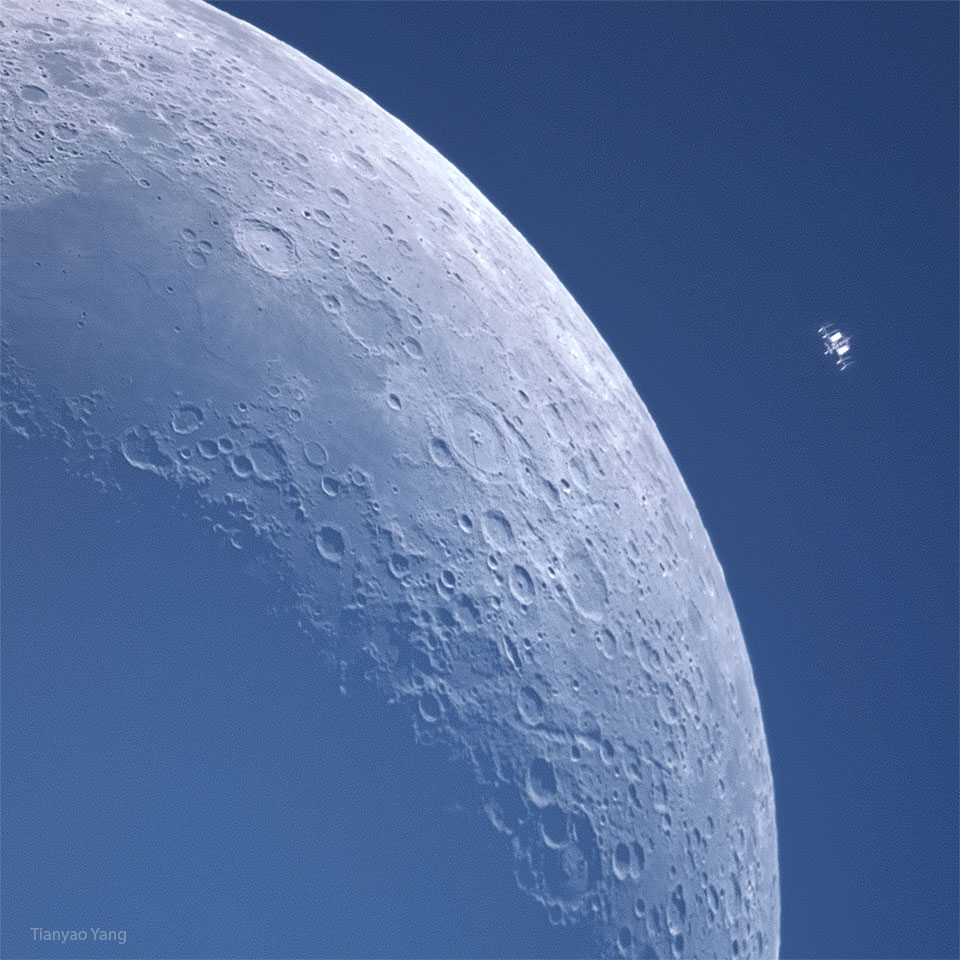12. June 2023
地球上大粒 ê 衛星

探索宇宙1!逐工會揀一幅無仝款 ê 影像抑是相片,𤆬你熟似咱這个迷人 ê 宇宙,閣有專業天文學者2為你解說3。
- 原始文章:The Largest Satellites of Earth
- 影像來源 kah 版權:Tianyao Yang
- 台文翻譯:An-Li Tsai (NCU)
[漢羅] 地球上大粒 ê 衛星
月球附近彼个是啥物? 是 國際太空站 ISS 啦! 雖罔講 ISS 實際上有可能出現 tī 月球 附近,毋過這張相片毋是按呢,這張是出現 tī 地球 附近。 ISS 是 tī 低地球軌道 leh 行,伊每 90 分鐘 踅咱這粒 大粒藍色寶石 一擺。 相片內底翕著 ê,是伊 ùi 月球頭前飛過。 月球 踅地球 leh 行,一輾愛行 1 個月。 這个時期 ê 月相是月眉形–ê,這是因為月球 去予日光照著 ê 彼半爿,tī 地球看起來 干焦賰彎彎 ê 光帶。 這張影像是三月底 tī 中國 上海 翕–ê。 這毋但會當看著地球 上大粒人工衛星 ê 細節,嘛會當看著地球上大粒天然衛星 足清楚詳細 ê 隕石坑 kah 拋荒表面。 閣紲落來幾若年,人類按算欲送比以前 閣較濟人 kah 機器 到 月球 去。
[POJ] Tē-kiû siōng tōa-lia̍p ê Ūi-chhiⁿ
Ge̍rh-kiû hù-kīn hit-ê sī siáⁿ-mih? Sī kok-chè-thài-khong-chām ISS lah! Sui-bóng kóng ISS si̍t-chè-siōng ū khó-lêng chhut-hiān tī Ge̍rh-kiû hù-kīn, m̄-koh chit-tiuⁿ siòng-phìⁿ m̄-sī án-ne, chit-tiuⁿ sī chhut-hiān tī Tē-kiû hù-kīn. ISS sī tī kē Tē-kiû kúi-tō leh kiâⁿ, i múi 90 hun-cheng se̍rh lán chit-lia̍p tōa-lia̍p nâ-sek pó-chio̍h chi̍t-liàn. Siòng-phìⁿ lāi-tóe hip-tio̍h ê, sī i ùi Ge̍rh-kiû thâu-chêng per-kèr. Ge̍rh-kiû se̍rh Tē-kiû leh kiâⁿ, chi̍t-liàn ài kiâⁿ 1 kò ge̍rh. Chit-ê sî-ki ê ge̍rh-siòng sī ge̍rh-bâi hêng–ê, che-sī in-ūi Ge̍rh-kiû khì hō͘ ji̍t-kng chiò-tio̍h ê hit pòaⁿ-pêng, tī Tē-kiû khòaⁿ–khí-lâi kan-na chhun oan-oan ê kng-tòa. Chit-tiuⁿ iáⁿ-siōng sī saⁿ ge̍rh-tóe tī Tiong-kok Siōng-hái hip–ê. Che m̄-nā ē-tàng khòaⁿ-tio̍h Tē-kiû siōng tōa-lia̍p jîn-kang ūi-chhiⁿ ê sè-chiat, mā ē-tàng khòaⁿ-tio̍h Tē-kiû siōng tōa-lia̍p thian-jiân ūi-chhiⁿ chiok chheng-chhó͘ siông-sè ê ún-se̍k-khiⁿ kah pha-hng piáu-bīn. Koh sòa–lo̍h-lâi kúi-nā nî, jîn-lūi àn-sǹg beh sàng pí í-chêng koh khah-chōe lâng kah ki-khì kàu Ge̍rh-kiû khì.
[KIP] Tē-kiû siōng tuā-lia̍p ê Uī-tshinn
Ge̍rh-kiû hù-kīn hit-ê sī siánn-mih? Sī kok-tsè-thài-khong-tsām ISS lah! Sui-bóng kóng ISS si̍t-tsè-siōng ū khó-lîng tshut-hiān tī Ge̍rh-kiû hù-kīn, m̄-koh tsit-tiunn siòng-phìnn m̄-sī án-ne, tsit-tiunn sī tshut-hiān tī Tē-kiû hù-kīn. ISS sī tī kē Tē-kiû kuí-tō leh kiânn, i muí 90 hun-tsing se̍rh lán tsit-lia̍p tuā-lia̍p nâ-sik pó-tsio̍h tsi̍t-liàn. Siòng-phìnn lāi-tué hip-tio̍h ê, sī i uì Ge̍rh-kiû thâu-tsîng per-kèr. Ge̍rh-kiû se̍rh Tē-kiû leh kiânn, tsi̍t-liàn ài kiânn 1 kò ge̍rh. Tsit-ê sî-ki ê ge̍rh-siòng sī ge̍rh-bâi hîng–ê, tse-sī in-uī Ge̍rh-kiû khì hōo ji̍t-kng tsiò-tio̍h ê hit puànn-pîng, tī Tē-kiû khuànn–khí-lâi kan-na tshun uan-uan ê kng-tuà. Tsit-tiunn iánn-siōng sī sann ge̍rh-tué tī Tiong-kok Siōng-hái hip–ê. Tse m̄-nā ē-tàng khuànn-tio̍h Tē-kiû siōng tuā-lia̍p jîn-kang uī-tshinn ê sè-tsiat, mā ē-tàng khuànn-tio̍h Tē-kiû siōng tuā-lia̍p thian-jiân uī-tshinn tsiok tshing-tshóo siông-sè ê ún-si̍k-khinn kah pha-hng piáu-bīn. Koh suà–lo̍h-lâi kuí-nā nî, jîn-luī àn-sǹg beh sàng pí í-tsîng koh khah-tsuē lâng kah ki-khì kàu Ge̍rh-kiû khì.
[English] The Largest Satellites of Earth
What’s that near the Moon? It’s the International Space Station (ISS). Although the ISS may appear to be physically near the Moon, it is not — it is physically near the Earth. In low Earth orbit and circulating around our big blue marble about every 90 minutes, the ISS was captured photographically as it crossed nearly in front of the Moon. The Moon, itself in a month-long orbit around the Earth, shows a crescent phase as only a curving sliver of its Sun-illuminated half is visible from the Earth. The featured image was taken in late March from Shanghai, China and shows not only details of Earth’s largest human-made satellite, but details of the cratered and barren surface of Earth’s largest natural satellite. Over the next few years, humanity is planning to send more people and machines to the Moon than ever before.
詞彙學習(漢羅/POJ/KIP/華語/English)
- 【國際太空站】Kok-chè-thài-khong-chām/Kok-tsè-thài-khong-tsām/國際太空站/International Space Station (ISS)
- 【低地球軌道】kē Tē-kiû kúi-tō/kē Tē-kiû kuí-tō/低地球軌道/low Earth orbit
- 【月球】Ge̍rh-kiû/Ge̍rh-kiû/月球/Moon
- 【月相】ge̍rh-siòng/ge̍rh-siòng/月相/moon phase
- 【月眉】ge̍rh-bâi/ge̍rh-bâi/弦月/crescent
- 【隕石坑】ún-se̍k-khiⁿ/ún-si̍k-khinn/隕石坑/crater
- 【人工衛星】jîn-kang ūi-chhiⁿ/jîn-kang uī-tshinn/人工衛星/human-made satellite
- 【天然衛星】thian-jiân ūi-chhiⁿ/thian-jiân uī-tshinn/天然衛星/natural satellite